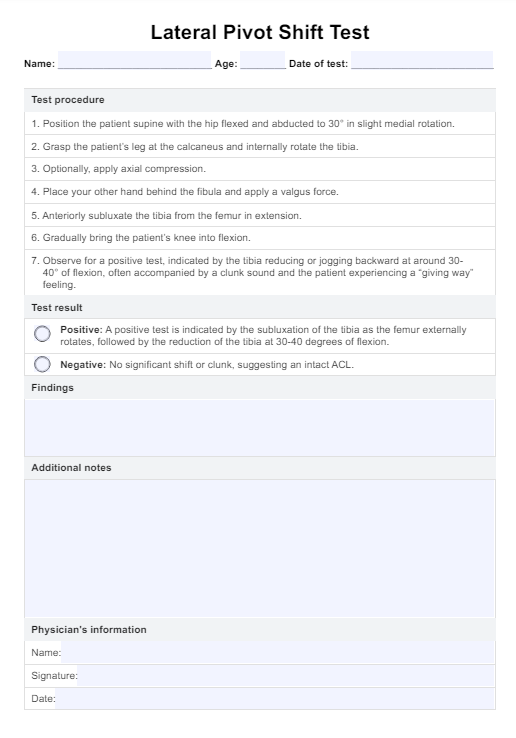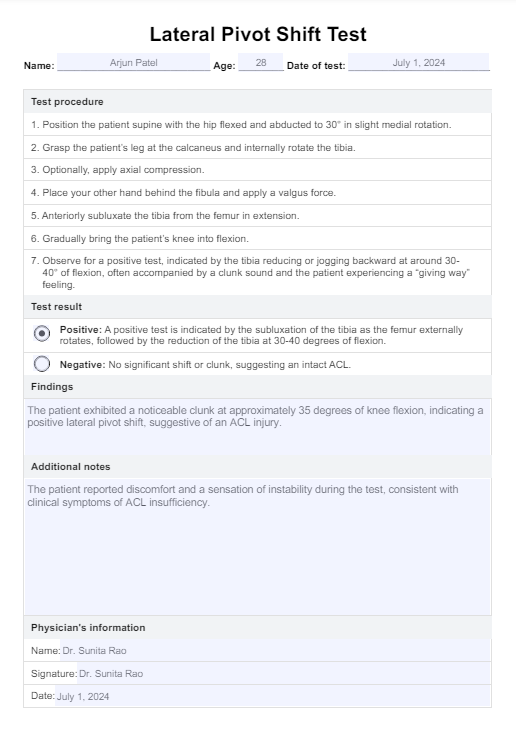Lateral Pivot Shift Test
Learn more about the Lateral Pivot Shift Test, a vital tool for diagnosing ACL injuries. Understand how it's conducted, its benefits, and treatment options.


What is an anterior cruciate ligament tear?
An anterior cruciate ligament (ACL) tear is a common injury in the knee, involving the internal rotation of the tibia relative to the femur. When comparing the proximal tibia to the distal femur, the ACL plays a crucial role in stabilizing the knee by preventing excessive tibial rotation. The cruciate ligaments, namely the anterior and posterior cruciate ligaments, cross each other to form a stabilizing structure within the knee joint. An ACL rupture can lead to significant instability and impaired function, often necessitating surgical intervention.
In an ACL-deficient knee, the stability of the joint is compromised, which can result in the pivot shift phenomenon, where the lateral meniscus experiences undue stress. This instability can be clinically evaluated using tests such as the anterior drawer sign, which assesses the forward movement of the tibia in relation to the femur. An understanding of internal tibial rotation and the biomechanics involved in knee movement is essential for diagnosing and treating ACL injuries effectively.
Symptoms of an ACL tear
Here are the most common symptoms of an ACL tear, also known as anterior cruciate ligament injury:
- A loud "pop" sound at the time of injury
- Severe pain and inability to continue activity
- Rapid swelling
- Loss of range of motion
- A feeling of instability or "giving way" when bearing weight
Causes of ACL tears
ACL tears typically occur due to:
- Sudden stopping or changing direction quickly
- Slowing down while running
- Incorrectly landing from a jump
- Direct collision, such as during a football tackle
These movements put great stress on the ACL, leading to its tear if the force is beyond what the ligament can handle. Sudden, intense movements can also lead to anterior cruciate ligament ruptures.
Lateral Pivot Shift Test Template
Lateral Pivot Shift Test Example
What is a Lateral Pivot Shift Test?
The lateral pivot shift test is a clinical examination used to assess the integrity of the ACL in the knee. It helps to determine if there is instability or a partial tear in the ACL. This test is particularly useful for diagnosing injuries that affect the knee's ability to remain stable during rotational movements.
How is this test conducted?
The test is performed by a medical professional as follows:
- The patient lies supine with the hip flexed, abducted to 30°, and slightly medially rotated.
- The examiner grasps the patient’s leg at the calcaneus and internally rotates the tibia.
- Optionally, the examiner can apply axial compression.
- The examiner places their other hand behind the fibula and applies a valgus force.
- Then, they anteriorly subluxated the tibia from the femur in extension and gradually bring the knee into flexion.
- A positive test is indicated by the tibia reducing or jogging backward at 30-40° of flexion, often with a clunk sound and the patient feeling a “giving way” sensation.
How are the results interpreted?
Results of the lateral pivot shift test are interpreted based on the movement observed in the knee:
- Positive result: A noticeable shift or clunk in the knee joint around 30 to 40 degrees of knee flexion suggests an ACL injury. A positive pivot shift test generally suggests an ACL injury.
- Negative result: No significant shift or clunk indicates that the ACL may be intact
Next steps after conducting this test
After conducting the lateral pivot shift test and interpreting the results, a series of steps follow to ensure appropriate management and care for the patient. These steps are critical for planning the right treatment strategy to restore stability and function to the knee.
- Review the results: The clinician reviews the test results to confirm the presence or absence of an ACL injury.
- Further diagnostic imaging: If the test indicates potential damage, further diagnostic tests such as MRI may be recommended to assess the extent of the injury.
- Consultation with a specialist: A consultation with an orthopedic specialist may be necessary to discuss treatment options based on the severity of the injury.
- Plan treatment: Treatment may include physical therapy, bracing, or surgical intervention, depending on the individual case and clinical recommendations. Patients with a history of chronic knee injuries may require further specialized assessments.
How to use our Lateral Pivot Shift Test template
Using our Lateral Pivot Shift Test template effectively can streamline the diagnostic process and improve the accuracy of your assessments for ACL injuries. Below are step-by-step instructions on how to utilize this template in your clinical practice.
Step 1: Gather patient information
Start by filling in the patient's full name, date of birth, date of the test, and patient ID. This information is crucial for record-keeping and ensuring that the test results are accurately associated with the correct patient.
Step 2: Record clinical history
Document the reason for the examination and any relevant medical history, particularly any previous knee injuries or surgeries. This background is essential for contextualizing the test results and planning further treatment or investigation.
Step 3: Conduct the test
Follow the detailed steps outlined in the test procedure section of the template. Begin by positioning the patient, then proceed through the maneuvers to apply the necessary forces while observing the knee's response. Accurately noting each step ensures consistency and reliability in testing.
Step 4: Analyze the results
Record the findings from the test, noting any observed mechanical responses such as shifts or clunks. Classify the test outcome as positive or negative based on these observations, which will guide the next steps in diagnosis and treatment.
Step 5: Make recommendations
Based on the test results, provide recommendations for further diagnostics, such as an MRI, additional tests, or referrals to specialists. This step is critical for advancing the patient's care path efficiently and effectively.
Step 6: Complete documentation
Finish by filling out the physician’s notes with any additional observations or relevant patient responses during the test. Ensure that the performing physician's name, signature, and date are documented, which is vital for legal and medical record-keeping.
Benefits of conducting this test
The lateral pivot shift test offers several benefits in diagnosing and managing knee injuries. It is particularly valuable for diagnosing anterior cruciate ligament instability. Here are some key advantages:
- Early detection of ACL instability: This test can detect subtle instabilities in the knee that might not be apparent with other examinations. Early detection can lead to more effective management strategies and prevent further injury.
- Improved diagnostic accuracy: The lateral pivot shift test adds valuable information to the clinical evaluation of a suspected ACL injury. When combined with other tests and imaging techniques, it improves the overall diagnostic accuracy, helping ensure that treatment is appropriately targeted.
- Non-invasive assessment: The test is a non-invasive physical maneuver that does not require any special equipment or radiation exposure. This makes it a safe option for initial assessment before proceeding to more invasive or costly diagnostics like MRI.
- Guidance for treatment decisions: A positive result on the lateral pivot shift test can help confirm the diagnosis of an ACL tear, guiding further treatment decisions. This could range from conservative management, such as physical therapy, to surgical intervention.
- Assessment of joint functionality: By replicating specific movements that may cause the knee to pivot abnormally, the test provides insights into the knee's functional limitations, which can be important for planning rehabilitation or deciding on the necessity of surgical repair.
- Patient education: Performing the test can be educational for patients, helping them understand the nature of their injury and the importance of following through with recommended treatments or surgery to prevent further damage.
ACL tear treatments
Treatment for an anterior cruciate ligament (ACL) tear can vary depending on the severity of the injury, the individual’s activity level, and their goals for recovery. Here are some common treatment options:
Conservative treatment
Conservative treatments are generally recommended for individuals with low activity demands or those who can modify their lifestyle to accommodate the injury. This approach may include:
- Physical therapy: A rehabilitation program focused on strengthening the muscles around the knee, improving flexibility, and increasing stability.
- Bracing: Wearing a knee brace to stabilize the knee and prevent further injury during activities.
- Activity modification: Avoid activities that involve jumping, pivoting, or intense physical exertion.
Surgical treatment
Surgical treatment is often recommended for athletes or individuals who wish to return to high levels of activity. The most common procedure is ACL reconstruction, which involves:
- Graft selection: The torn ligament is replaced with a graft, which can be taken from another part of the patient’s body (autograft) or a donor (allograft).
- Reconstruction surgery: The surgeon removes the damaged ligament and replaces it with the graft, securing it to the bones of the knee joint.
- Post-operative rehabilitation: Following surgery, an extensive rehabilitation program is necessary to restore knee function and strength.
Emerging treatments
Research continues into new treatment options, including:
- Biological treatments: These involve using techniques such as stem cells or growth factors to stimulate ligament healing without the need for surgery.
- Minimally invasive techniques: Developing surgical methods that reduce the impact on surrounding tissues and potentially speed up recovery times.
Long-term management
Regardless of whether treatment is conservative or surgical, long-term management is crucial to prevent re-injury and manage symptoms. This might include:
- Ongoing physical therapy: To maintain knee strength and flexibility.
- Regular exercise: Engaging in low-impact exercises as a part of daily life.
- Weight management: Keeping a healthy weight to reduce stress on the knee.
Deciding on the right treatment involves discussions between the patient and healthcare provider, considering their lifestyle, age, health, and the activities they wish to return to post-recovery.
Commonly asked questions
The pivot shift test is a physical examination used to assess the integrity of the anterior cruciate ligament (ACL) in the knee. It involves flexing and externally rotating the knee while applying a valgus force, or pressure from the outside of the knee.
A positive result typically indicates instability in the knee, suggesting a potential injury to the anterior cruciate ligament (ACL) . However, a negative result does not exclude the possibility of anterior cruciate ligament insufficiency.
The test can be uncomfortable, especially if there is an existing knee injury, but it should not cause significant pain when performed correctly by a healthcare professional.






















-template.jpg)
















































































